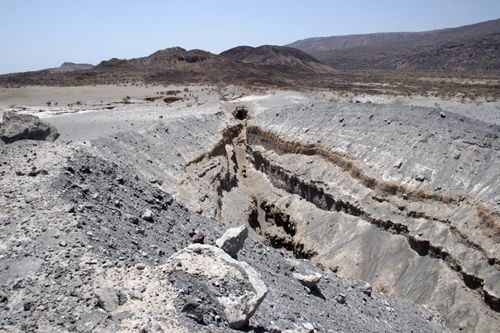East Africa: The desert is at risk of turning into a sea
East Africa is at risk of being separated from Africa, with deserts that can turn into oceans due to earthquakes and volcanoes creating large fissures that cause seawater to enter.
With many deep cracks stretching tens of kilometers, creating conditions for sea water to enter the desert to form a new ocean . The African continent is in danger of being split into two separate parts, with cracks stretching for thousands of kilometers: from Ethiopia to Mozambique. The chain of volcanoes in East Africa is the ' pioneers ' in separating the continent. The earthquake created deep valleys in the middle of the desert and the structure of East Africa is shattered like glass.
Millions of years ago, a similar crack created the Red Sea and Gulf of Aden. One cannot rule out a few million years later, a second Red Sea will appear in African territory.

Deep cracked groove stretches up to 60 kilometers
The ocean is currently entering the Danakil valley. Only a 25-meter hill prevented sea water in Hong Hai from entering the territory tens of meters below sea level. The layers of salt remaining on the surface of the low-lying area indicate that seawater once flooded the area.
When will the sea water enter the desert? Leeds University Tim Tim (UK) scientist said: ' With the current unstable strata, the hill above can be subsided and disappear within a few days '. Until then, nothing could stop the sea water from entering the Danakil basin. Mr. Wright said that in the past five years, ocean formation has accelerated in an ' unimaginable ' way, creating deep fissures : meters wide and dozens of kilometers long.
According to researchers, volcanic activity in East Africa is becoming more intense and lava blocks at 22 points in the Afar triangle are approaching the ground, but not to the extent of a volcanic eruption. Erta Ale.
The composition of the medium-erupted lava in November 2010 in Erta Ale also surprised the scientific community. They are just like lava erupting from volcanoes lying in the deep sea floor. The only other is that they are not cooled by seawater.
The process of ' dividing Africa ' began to show clearly in 2005, when there were cracks of 60km long in the lowlands of Afar. Since that time, there have been 3.5 km3 of rising lava - a huge amount enough to cover the city of London with a thickness of people.
Satellite measurements show that a long section of up to 200km has lava on the ground as if the asphalt is melted under the hot summer afternoon sun.
Satellite data show that many parts of East Africa are under the influence of lava emerging on the ground. In eastern Egypt, lava flows are heating the ground temperature. In the desert of Malawi in Malawi, a lava range of up to 17 km is emerging, pushing the ground here half a meter higher.
Not only that, volcanoes erupt in places where the scientific community did not expect. It is the eruption of an underground volcano in Saudi Arabia, 200km from the crack in Africa. This suggests that a large volume of lava is increasingly accumulating in a large area and signaling that in the next 10 years, earthquakes and volcanoes will operate more frequently in East Africa.
Some of the following pictures signal the process of 'turning the desert into an ocean in East Africa:

Erta Ale volcano in Ethiopia erupted violently

The ground is lava made like a hot midday summer asphalt

Lava turns the desert into a lake without water

Earthquakes and volcanoes create cracks of tens of kilometers long

Satellite measurement shows the process of splitting East Africa

The process of forming "Red Sea" in East Africa
- Amazon forests are at risk of turning into desert
- Project to turn desert into ... forest
- 8 false rumors that everyone believes in Africa
- Africa faces the risk of breaking in half: Cracks long thousands of meters are evidence
- Arid desert 'risen' covered with roses
- Many deserts ... water
- 10 million Africans are at risk of drought
- Africa's most bizarre fox: Cute to beat but even hunted newspapers
- The appearance of huge fissures, evidence of Africa began to split into two, forming a new continent
- Dust storms from the Sahara desert cause an explosion of plankton in the East Atlantic Ocean
- The most exotic deserts in the world
- Great Rift Valley Rift Great Rift
 Is the magnetic North Pole shift dangerous to humanity?
Is the magnetic North Pole shift dangerous to humanity? Washington legalizes the recycling of human bodies into fertilizer
Washington legalizes the recycling of human bodies into fertilizer Lightning stone - the mysterious guest
Lightning stone - the mysterious guest Stunned by the mysterious sunset, strange appearance
Stunned by the mysterious sunset, strange appearance